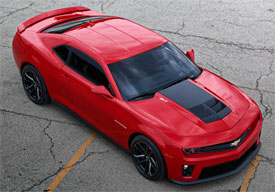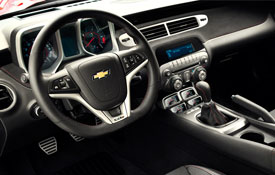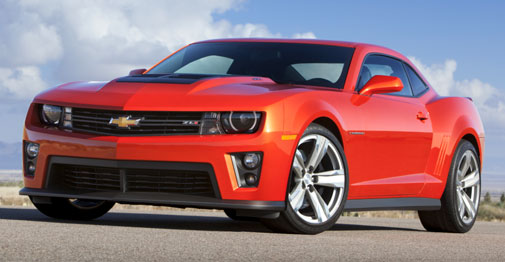2012 Chevrolet Camaro ZL1
Since the Chevrolet Camaro’s rebirth in 2010, sales have taken off right to the top of the pony car field, even outselling its main rival, the Ford Mustang. Yes, it does feel like 1969 all over again, as the pony car wars are continuing to heat up. Indeed the latest shot comes from the general is a 580-horsepower missile going by a familiar name… ZL1.
The 1969 Chevrolet Camaro ZL1 was a born to race, special edition, one year only Camaro, limited to just 69 units. The 2012 Chevrolet Camaro ZL1 has a few similarities to the ’69, but a lot more differences.
For starters, there’s no big-block under the hood, instead it’s GM’s LSA 6.2-liter V8. That’s the same supercharged pushrod pumper found in the Cadillac CTS-V. Improved air flow for both intake and exhaust, as well as updates to the supercharger and intercooler, boost horsepower to 580 and torque to 556 pound feet.
 Another big difference from the original ZL1 that was designed strictly for drag racing, this new ZL1 feels at home on any type of track. As with just about every GM performance car to come along in the last decade, it was designed on Germany’s Nurburgring. While we didn’t sample it there, we did our laps at the closest thing we have in this country, VIR. Virginia International Raceway is a track with lots of high speeds, off camber turns, and elevation changes. It’s not for the faint of heart. And neither is the ZL1. Starting with a Camaro SS, the ZL1 adds stiffer suspension bushings all around, a redesigned rear stabilizer bar, and most importantly, a new version of GM’s Magnetic Ride control.
Another big difference from the original ZL1 that was designed strictly for drag racing, this new ZL1 feels at home on any type of track. As with just about every GM performance car to come along in the last decade, it was designed on Germany’s Nurburgring. While we didn’t sample it there, we did our laps at the closest thing we have in this country, VIR. Virginia International Raceway is a track with lots of high speeds, off camber turns, and elevation changes. It’s not for the faint of heart. And neither is the ZL1. Starting with a Camaro SS, the ZL1 adds stiffer suspension bushings all around, a redesigned rear stabilizer bar, and most importantly, a new version of GM’s Magnetic Ride control.
And the result is… while it still feels a little on the heavy side, this car handles way better than you’re expecting. A new electric power steering unit feels neutral and is very responsive; the Performance Traction Management has five settings to suit track conditions or your driving experience. The Brembo brakes are by far the best we’ve ever experienced on a Camaro; it was hard to get our heads around using them as hard as we were. We didn’t get nearly enough laps to truly find their limits.
On the street, the ride is far from harsh, seating is comfortable, and the ZL1 is fairly well-mannered. 30% of the ZL1’s parts are unique, but most of them you can’t see, like aerodynamic enhancements under the body, a new rear differential that shares the transmission coolant, and additional pick-ups in the fuel tank.
Exterior enhancements are much easier noticed, and include a big front splitter, a new grille that feeds large brake cooling ducts and a carbon fiber hood with vents that not only get air out of the engine bay but provide additional front end down force as well. There are also extended rockers and fenders, and of course a rear spoiler. 20-inch wheels are standard and wrapped in Good Year Eagle F1’s, 285/35’s up front, 305/35’s in the rear.
 Inside, the ZL1 gets a mild make-over with suede leather replacing the plastic trim on the dash and doors. The improved seats also get the suede treatment, and an optional Suede Package spreads hide onto the steering wheel and shifter as well. It’s also loaded. Bluetooth, back-up cam, and even Head-up Display, are all standard. You have your choice of 6-speed transmissions, manual or automatic; and just as in the CTS-V, the automatic is actually quicker to 60 by a tenth at 3.9-seconds. Top speed…180!
Inside, the ZL1 gets a mild make-over with suede leather replacing the plastic trim on the dash and doors. The improved seats also get the suede treatment, and an optional Suede Package spreads hide onto the steering wheel and shifter as well. It’s also loaded. Bluetooth, back-up cam, and even Head-up Display, are all standard. You have your choice of 6-speed transmissions, manual or automatic; and just as in the CTS-V, the automatic is actually quicker to 60 by a tenth at 3.9-seconds. Top speed…180!
But, the manual achieves better Government Fuel Economy Ratings at 14-City and 19-Highway, while the automatic manages just 12 and 18. Those low numbers do warrant a Gas Guzzler Tax; still, much like the Chevrolet Corvette, the Camaro ZL1 delivers world class performance, without an exotic price tag, starting at just $54,995, with very few options available.
The 2012 Chevrolet Camaro ZL1 is a truly contemporary muscle car. More than just a flimsy pony car made for the drag strip, it’s a high performance missile that can streak around any corner. And, it has clearly shot the Camaro to the top of the pony car field for now. With a 650-horsepower Shelby GT 500 Mustang on the way, will the ZL1 stay there for long? Well we can’t wait to find out. Welcome back to the 60’s - peace, love, and muscle cars, baby!
Specifications
- Engine: 6.2-liter V8
- Horsepower: 580
- Torque: 556 lb-ft.
- 0-60 mph: 3.9 seconds
- EPA: 14 mpg city/ 19 mpg highway (manual)
2024 Polestar 2
More Range And More Power For The Polestar 2
Volvo is well on their way to making the transition to an all-electric brand, but their sister-brand Polestar is already there. Now, we’ve spent lots of time in their all-wheel drive, five-door Polestar 2, having tested it in 2021, and a year later when a two-wheel drive version arrived. But, EV updates are coming quickly. So, let us be your guide for all that’s new with the Polestar 2.
While we are driving more EVs than ever, we’ve also been spending a lot of time recently circling back to ones we’ve previously tested. As in this new era of electrified vehicles, significant updates are arriving quickly, with R&D investments increasing and retrofitting them easier than ever. This is often done through software updates that can even be accomplished over the air. For 2024, the Polestar 2 has indeed gotten some software updates, but some physical ones as well.
Clearly aimed directly at Tesla’s Model 3 when it arrived; the Polestar 2’s build quality was vastly better, but range definitely came up short. So, addressing that was priority No. 1; and for ’24 the Polestar can travel up to 20% farther than before while consuming 9% less energy, and when it comes time to charge it back up, it can do that 34% faster too.
Range in the Single Motor version increases from a max of 270 to 320 miles thanks to a larger 82-kWh battery pack, and that solitary motor now powers the rear wheels, not the front wheels. It’s also bigger, coming in at 220 kW compared to the previous 170 kW front-wheel drive version, going from 231 to 299 horsepower.
Dual Motors keep the same 78-kWh battery, but still sees a boost from 260 to 276 miles and takes advantage of the larger rear motor for a new combined 310-kW output with 421 horsepower. Our test car has the added Performance Pack, which uses an additional 35 kW to deliver 455 horsepower and 546 lb-ft of torque, though max range drops to just 247 miles.
The new battery in rear-drive 2s will also charge faster, now accepting up to 205 kW for an 80% charge in 20 minutes; max for dual-motors stays at 155 kW, which puts an 80% charge at 34 minutes. Using 32 kWh of electricity per 100 miles, the Dual Motor earns a good efficiency rating.
The [Polestar] 2 has always been one of the most enjoyable EVs to drive, even more so now with that additional power coming from the rear motor.
Unfortunately, extremely cold temperatures kept us from seeing that increased range, as we were only on pace for about 194 miles in our test.
The 2 has always been one of the most enjoyable EVs to drive, even more so now with that additional power coming from the rear motor. And especially when equipped with the Performance Pack as it not only includes more power, but adds 20-inch forged wheels, upgraded brakes, and adjustable Ohlins Dual Flow Valve performance dampers. It greatly improves handling prowess without affecting ride quality, and is easily worth the $5,500 charge if you at all enjoy driving.
Even on a 20-degree track day there was plenty of grip through our handling course. No understeer or oversteer, and lots of feedback through the wheel. There was a nice, strong launch off the line that properly planted us firmly in the seat, and rocketed us to 60 in 4.5 seconds. Power delivery stayed pretty intense up until about 80 mph when there was a definite tapering off. Still, it was a 13.4-second quarter-mile at 102 mph; smooth, quiet, and stable the whole way.
When this car debuted, its Google-based infotainment setup was a novelty, but since then, more and more manufacturers are just “Googling it” so it doesn’t seem out of place at all. The wireless phone charger is easy to access, and there’s a great Harmon/Kardon sound system and panoramic sunroof to enhance the in-cabin experience. Exteriors have also been enhanced with a smooth grille insert and new wheel choices.
Hatchback practicality means 14.3 cu-ft of easy to access cargo space with split-folding seatbacks for longer items and expanding the space to 38.7 cu-ft. Plus, there’s even a sizeable storage bin up front under the hood.
Single Motor Polestar 2 pricing now starts at $51,300, with Dual Motors starting at $56,700; topping out at $64,400.
For a car manufacturer that hasn’t even been around for a decade yet, Polestar has kept itself busy, totally transforming their latest model in just a few years, making the 2024 Polestar 2 even more appealing. They are certainly off to a good start, and with a host of Polestars just over the horizon, including some all-important utility vehicles, this star will be shining even brighter.
Specifications
As Tested
- Motor Setup: Dual Motor
- Horsepower: 455
- 0-60 mph: 4.5 seconds
- EPA Range: 247 miles
- Efficiency : 32 kWh / 100 miles
- Battery Size: 78-kWh
- Torque: 546 lb-ft
- 1/4 Mile: 13.4 seconds at 102 mph
- MW Test Loop: ~ 194 miles
- Peak Charging Rate: 155 kW











































